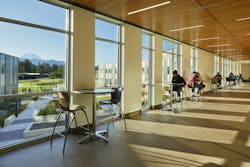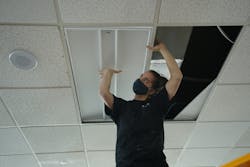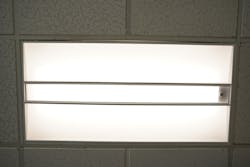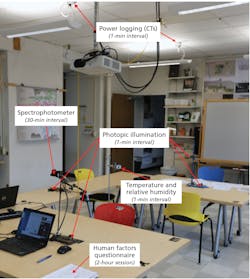A high school near Seattle is anticipating savings of about 137,000 kWh annually through its recent installation of luminaire-level lighting controls (LLLC), according to a new case study by BetterBricks — an initiative funded by the Northwest Energy Efficiency Alliance (Fig. 1; see PDF summary). It shows the potential of energy savings for large high schools.
While modern connected lighting systems offer products that provide futureproofing solutions, school retrofits still pose many challenges. This is because schools require affordable and flexible lighting that can be easily adaptable to many different spaces and uses. Areas such as classrooms, libraries, gyms, and auditoriums are multi-purpose, serving different audiences and activities during the day and evenings, and they can all require different hardware strategies. Additionally, each of these areas requires different daylight calculations, wiring for zones, and commissioning in order to meet energy codes.
LLLC is uniquely positioned to support schools because it includes wireless integrated occupancy and daylight sensors at every fixture. Many LLLC systems are new fixtures with a simple out-of-the-box setup (Fig. 2). For buildings with existing linear fluorescent fixtures, retrofit kits are available.
Many LLLC products allow control through an app or tablet, which gives school staff the wireless ability to quickly dim or change the color of lights. Some systems offer wireless keypads that can be mounted anywhere for simple adjustments by faculty, such as dimming at the whiteboard. This technology can also provide remote programming through the same app, so facility managers can make any adjustments that are needed.
When looking at the material and labor investment of LLLC, research from the University of Oregon (UO) found LLLC is a cost-competitive alternative to a full redesign that incorporates networked lighting controls (NLC). NLC is a combination of sensors, network interfaces, and controllers that allow lighting systems to be adjusted; however, they are not part of the fixtures.
How LLLC stacks up
LLLC has a networked occupancy sensor and ambient light sensor installed for each luminaire kit (Fig. 3). LLLC includes sensors and control logics for programmability at each individual luminaire, whereas standard hardwired or networked controls typically control circuits — or switch legs — for groups of fixtures using relays to turn them on and off.
LLLC offers granular possibilities for controls, and as we continue to move forward in a more connected world, people are looking for a better occupant experience, including educational facilities.
So how do we define “better occupant experiences”? For students and staff, LLLC settings can create healthy and comfortable spaces. This can include:
- Flexible light levels to provide appropriate lighting for specific task requirements
- Color tuning capabilities to adjust from warm colors to cooler temperature
- Dimming through wireless scene controllers to fit the mood or task needs
- Daylight harvesting and glare control (windows, skylights, and shade integration)
To experiment with the idea of “better occupant experiences,” UO researchers conducted a study at a lab space on their campus to see if LLLC provided a quality lighting product with energy savings equal to a full lighting redesign (Fig. 4). The study examined LLLC as a 1:1 retrofit, which is defined as retrofitting or replacing each fixture in its existing location without moving or changing the number of fixtures in a space. The study defined a redesign as removing existing lights and installing fixtures in new locations, designed to fit the current space.
LLLC systems were chosen from the DesignLights Consortium (DLC) Networked Lighting Control qualified products list to represent the 1:1 replacement retrofit solutions, and a fifth system that utilized NLC was chosen as part of a full redesign solution.
All five systems were compared to a fluorescent baseline, and the redesign solution employed a zoning approach that grouped luminaires into perimeter, middle, and core zones. Each system was installed and tested sequentially in three-week periods. Participants were recruited to perform computer- and paper-based tasks and fill out questionnaires. They evaluated light quality, brightness, distribution, and more while indoor and outdoor environmental metrics were recorded. Other factors included duration of install, equipment and labor costs, and other open-ended feedback from the installer.
The results showed that LLLC 1:1 systems range between one-third to one-half the cost of more comprehensive NLC solutions. Energy savings ranged from 50% to 74% over the baseline. The study also found benefits beyond energy savings among the participants, who reported key feedback such as seeing better and feeling less strain on their eyes with an LLLC system installed.
What contributes to the significant energy savings is that LLLC systems utilize several control strategies and are designed to give granular control to facility or building managers. For example, an occupancy sensor may save 35%, daylight dimming saves an additional 20%, and high-end trim another 10%. These build upon each other and can deliver significant cost savings, which impacts the return on investment.
“With 1:1 replacements, you may end up with underlit spaces if you didn’t have the right number of fixtures in there to begin with, but more commonly over-lit spaces, when you bring in new LED fixtures that have more output, or just a perception of greater brightness in the fixture design, which I think is getting better and better as we move forward. With high-end trim comes the ability to dial those down to the IES [Illuminating Engineering Society] standards, even if you have a higher installed capacity,” said Kevin Van Den Wymelenberg — director at the Institute for Health in the Built Environment at UO — in a webinar unpacking the study. High-end trim refers to adjusting light level presets. “High-end trim brings it down so you can manage the energy savings and the potential for glare and discomfort.”
What being fully wireless means for schools
Many LLLC systems operate over fully wireless or low-energy mesh networks, which are software driven and leverage the existing hardware in smartphones or tablets for communication.
It gives facility managers at schools the power to configure through a smartphone or tablet app and continue adjusting lighting settings as needed. With a sensor in each fixture, the luminaires are connected with each other and can perform high-end trimming and daylight harvesting.
Educators also directly benefit from LLLC technology, because it allows them to adjust light levels to support various activities throughout the day, such as turning off certain areas of lights when using audio/visual equipment, dimming for quiet time, quick on/off to get students’ attention, whiteboard lighting settings, and color changing from warm to cool, to name a few.
All of this can be controlled from the instructor's location with an app or wireless switch. So, if the instructor is at the front of the class, they may be able to adjust light settings from where they are standing — rather than moving to a wall station that may be on the other side of the room.
Also, not only do app-based configurations offer maximum control granularity, but they support an easily reconfigurable backbone for future expandability. Additional capabilities can include scheduling, energy monitoring, and an automatic demand-response.
Each manufacturer's product offering varies, so facilities management teams should verify operational and control aspects before investing.
Put to the test at Enumclaw High School
A small but determined team of four facility managers at Enumclaw High School — about an hour east of Seattle — considered many lighting systems when a retrofit came along as part of a three-year construction project.
Like many school facilities teams, they considered TLEDs because of the affordability. However, most TLEDs are not designed for existing light fixtures, resulting in low-quality output and reflective lighting. Additionally, reduced-wattage fluorescent lamps (25W) weren’t working with existing ballasts.
Given LLLC’s ease of installation and flexibility in a space, the facilities management team decided to pilot a system by installing a sample of several fixtures in unused classrooms. By working with Washington’s Pacific Lamp & Supply Company, they found that LLLC was the right choice with just a few fixtures installed.
The facilities management team completed the installation by using an out-of-the-box product with wireless programming capabilities and 4000K LED lamps.
“The system replaces the existing troffer and ballast, and swings into place like the troffer that was removed. It operates on line voltage, either 120 or 277V,” said Enumclaw School District facilities coordinator Peter French, in the case study about the installation. “Then you just walk around with a tablet and program the fixtures however you’d like. It’s just very simple, no control wiring involved — something our in-house crew can easily install and program.”
Once powered on, the team discovered the lights were too bright. By placing a photometer on a desk, the team found that they needed to dim the fixtures to about 70% of their output — something they could do right from a tablet. Even with the reduced output, the lighting intensity measured at 50 foot-candles.
Along with improved lighting quality came a nicer color temperature than the fluorescent, and it didn’t exhibit high-frequency flickering.
“We have received nothing but positive feedback,” said French. “Some of the spaces with new fixtures are offices like counseling centers, for example, where we are able to tune the light level to what they want. Wireless dimmers have worked really well in special education rooms that have a population that is more sensitive to brighter lights. Most are choosing less light, resulting in even more energy savings.”
To fund the installation, Enumclaw School District and Pacific Lamp decided to apply for an incentive of $35,800 through their local utility, Puget Sound Energy. The technology met Puget Sound Energy’s requirements and allowed the school district to recoup the installation cost after just four years.
Enumclaw High School anticipates 137,000 kWh in energy savings annually, reducing energy costs by $13,000 each year, which saves money for the school district. They’ve had no maintenance costs or failures since the installation.
LLLC is a futureproofing opportunity
The average school building in the US is more than 40 years old. Over the decades, technological advances unfolded, such as the transformation of classroom projectors and computers. Even more technical progress is on the horizon — and lighting is no exception.
Schools should consider LLLC as a lighting solution to futureproof their spaces. For example, most classroom lighting is wired in circuits with one switch controlling the “front bank” of lights; another circuit controls fixtures by the windows; and remaining fixtures are operated by yet another switch. If the room design changes, the lighting cannot be easily adjusted, it would require significant rewiring in the ceiling.
LLLC’s integrated sensors means a quick reprogramming and the entire room layout, including whiteboard location and desks, can be moved if the space is being converted to another use. It’s all simple reconfiguration. These benefits of LLLC also maximize school budgets.
For most K–12 schools, the decision isn’t just about immediate lighting needs but also the needs of their students and staff in future generations.
Get to know our expert
ANGELA PILANT has more than 25 years of experience working within the lighting and energy industries. She has a diverse background as a utility specialist, manufacturer’s representative, and consultant, working side by side with customers to upgrade their facilities with energy-efficient technology. She has worked at Evergreen Consulting Group since 2009 and specializes in market and trend analysis, utility program development, client engagement strategies, and training. Pilant is a certified instructor for the Building Operator Certification Program (BOC) and has developed and conducted cross-industry curriculum, including sales training, throughout the country. She has earned a Lighting Certified Professional designation from the National Council on Qualifications for the Lighting Professions (NCQLP).
*Evergreen Consulting Group works with utility programs and their customers to fulfill energy efficiency goals, and educates facility managers on how projects like Enumclaw High School can apply to their lighting needs.








